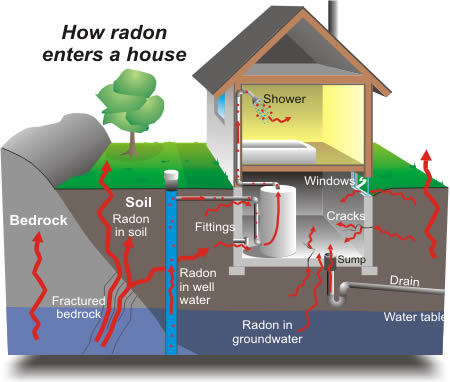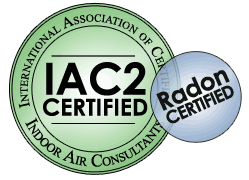 Radon Gas – TurningStone Home Inspection provides radon testing for clients at the time of the home inspection or as a single service. Inspector is a Certified Radon Measurement Provider.
Radon Gas – TurningStone Home Inspection provides radon testing for clients at the time of the home inspection or as a single service. Inspector is a Certified Radon Measurement Provider. Radon Gas Information
 Radon Gas – TurningStone Home Inspection provides radon testing for clients at the time of the home inspection or as a single service. Inspector is a Certified Radon Measurement Provider.
Radon Gas – TurningStone Home Inspection provides radon testing for clients at the time of the home inspection or as a single service. Inspector is a Certified Radon Measurement Provider.
How does Radon get into the Home? - There are cracks in the foundation. Nothing structural. Nothing that’s going to threaten the stability of the home, but they’re there. Nooks, crannies and holes through which seeps an invisible threat. Colorless, odorless and undetectable by your average human, it is none the less the second leading cause of lung cancer in the United States.
What is Radon gas? - even the name sounds ominous, evoking images of radiation and nuclear devastation is created when uranium in the soil decays. The gas then seeps through any access point into a home. Common entry points are cracks in the foundation, poorly sealed pipes, drainage or any other loose point. Once in the home, the gas can collect in certain areas especially basements and other low-lying, closed areas and build up over time to dangerous levels. The Environmental Protection Agency of the US Government has set a threshold of 4 pico curies per liter as the safe level. As humans are exposed to the gas over a period of years, it can have a significant and detrimental effect.
How widespread is the problem? - Radon has been found in homes in all 50 states. Certain areas are more susceptible than others fore more information you may visit the following website: https://www.epa.gov/radon/find-information-about-local-radon-zones-and-state-contact-information.
|
|
IMPORTANT: Consult the EPA Map of Radon Zones document (EPA-402-R-93-071) before using this map. This document contains information on radon potential variations within counties. EPA also recommends that this map be supplemented with any available local data in order to further understand and predict the radon potential of a specific area. If you have questions about radon in water, see https://archive.epa.gov/water/archive/web/html/index-9.html or contact your State Radon Coordinator.
No location is immune. Concentrations of radon-causing materials in the soil can be either natural or man-made. Homes built near historic mining operations may be at higher risk. The only way to tell for sure is to have a home tested.
How can it be Measured? - Testing for radon comes in two forms: active and passive. Active devices constantly measure the levels of radon in a portion of the home and display those results. Passive devices collect samples over a period of time and then are taken away and analyzed. Either method can help you determine your level of risk. Do-it-yourself kits are available from a number of outlets, normally with passive devices. Over a period of days, the device is left in the lowest level of the home which is normally occupied. This eliminates crawl spaces under the house, but includes finished or unfinished basements. Then the results are analyzed by a professional. The other option is to engage a qualified professional to conduct the tests properly. The EPA web site (https://www.epa.gov/radon/find-radon-test-kit-or-measurement-and-mitigation-professional) provides information on finding appropriate resources and testing devices.
What can I do if Radon is Found in my Home? - If high concentrations of radon are found in your home, you have several options. Since radon is only a problem when it is concentrated in high volume, improving the ventilation in an area is often sufficient to solve the problem. In other cases, it may be necessary to limit the amount of radon getting into the home by sealing or otherwise obstructing the access points. Once again, a professional should be engaged to ensure that the radon is effectively blocked. Typical radon mitigation systems can cost between $800 and $2500, according to the EPA.
If you’re buying or selling a home, radon can be a significant issue. Buyers should be aware of the radon risk in their area and determine whether a radon test is desirable. When in doubt, the EPA always recommends testing. The cost of the test can be built into the house price. If test results already exist, make sure they are recent or that the home has not been significantly renovated since the test was performed. If in doubt, get a new test done. If you’re selling a home, having a recent radon test is a great idea. By being proactive, you can assure potential buyers that there is no risk and avoid the issue from the start.
 |
So whether you have an old home or a new one, and live in Georgia, radon is a reality. But it is a reality that we can live with. Proper testing and mitigation can eliminate radon as a health threat. For more information, contact TurningStone Home Inspection or visit the EPA web site on radon at http://www.epa.gov/radon. |